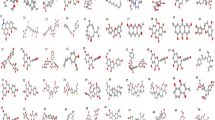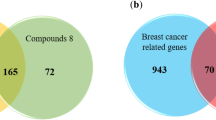Abstract
Many shreds of evidence have recently correlated A2B receptor antagonism with anticancer activity. Hence, the search for an efficient A2B antagonist may help in the development of a new chemotherapeutic agent. In this article, 23 new derivatives of [1,2,4]triazolo[4,3-a]quinoxaline were designed and synthesized and its structures were confirmed by different spectral data and elemental analyses. The results of cytotoxic evaluation of these compounds showed six promising active derivatives with IC50 values ranging from 1.9 to 6.4 μM on MDA-MB 231 cell line. Additionally, molecular docking for all synthesized compounds was performed to predict their binding affinity toward the homology model of A2B receptor as a proposed mode of their cytotoxic activity. Results of molecular docking were strongly correlated with those of the cytotoxic study. Finally, structure activity relationship analyses of the new compounds were explored.
Graphic abstract













Similar content being viewed by others
References
El Maatougui A, Azuaje J, González-Gómez M et al (2016) Discovery of potent and highly selective A2B adenosine receptor antagonist chemotypes. J Med Chem 59:1967–1983. https://doi.org/10.1021/acs.jmedchem.5b01586
Moro S, Deflorian F, Bacilieri M, Spalluto G (2006) Ligand-based homology modeling as attractive tool to inspect GPCR Structural plasticity. Curr Pharm Des 12:2175–2185. https://doi.org/10.2174/138161206777585265
Basu S, Barawkar DA, Ramdas V et al (2017) A2B adenosine receptor antagonists: design, synthesis and biological evaluation of novel xanthine derivatives. Eur J Med Chem 127:986–996. https://doi.org/10.1016/j.ejmech.2016.11.007
Betti M, Catarzi D, Varano F et al (2018) The aminopyridine-3,5-dicarbonitrile core for the design of new non-nucleoside-like agonists of the human adenosine A2B receptor. Eur J Med Chem 150:127–139. https://doi.org/10.1016/j.ejmech.2018.02.081
Merighi S, Mirandola P, Varani K et al (2003) A glance at adenosine receptors: novel target for antitumor therapy. Pharmacol Ther 100:31–48
Illes P, Klotz K-N, Lohse MJ (2000) Signaling by extracellular nucleotides and nucleosides. Naunyn Schmiedebergs Arch Pharmacol 362:295–298. https://doi.org/10.1007/s002100000308
Panjehpour M, Castro M, Klotz K-N (2005) Human breast cancer cell line MDA-MB-231 expresses endogenous A2B adenosine receptors mediating a Ca2+ signal. Br J Pharmacol 145:211–218. https://doi.org/10.1038/sj.bjp.0706180
Feoktistov I, Goldstein AE, Ryzhov S et al (2002) Differential expression of adenosine receptors in human endothelial cells: role of A2B receptors in angiogenic factor regulation. Circ Res 90:531–538
Kasama H, Sakamoto Y, Kasamatsu A et al (2015) Adenosine A2b receptor promotes progression of human oral cancer. BMC Cancer 15:563. https://doi.org/10.1186/s12885-015-1577-2
Popoli P, Pepponi R (2012) Potential therapeutic relevance of adenosine A2B and A2A receptors in the central nervous system. CNS Neurol Disord Drug Targets 11:664–674. https://doi.org/10.2174/187152712803581100
Aherne CM, Kewley EM, Eltzschig HK (2011) The resurgence of A2B adenosine receptor signaling. Biochim Biophys Acta Biomembr 1808:1329–1339. https://doi.org/10.1016/j.bbamem.2010.05.016
Müller CE, Jacobson KA (2011) Recent developments in adenosine receptor ligands and their potential as novel drugs. Biochim Biophys Acta Biomembr 1808:1290–1308. https://doi.org/10.1016/j.bbamem.2010.12.017
Sherbiny FF, Schiedel AC, Maaß A, Müller CE (2009) Homology modelling of the human adenosine A2B receptor based on X-ray structures of bovine rhodopsin, the β2-adrenergic receptor and the human adenosine A2A receptor. J Comput Aid Mol Des 23:807–828. https://doi.org/10.1007/s10822-009-9299-7
Gu W, Wang S, Jin X et al (2017) Synthesis and evaluation of new quinoxaline derivatives of dehydroabietic acid as potential antitumor agents. Molecules 22:1154. https://doi.org/10.3390/molecules22071154
El-Hawash SAM, Habib NS, Kassem MA (2006) Synthesis of some new quinoxalines and 1,2,4-triazolo[4,3-a]-quinoxalines for evaluation of in vitro antitumor and antimicrobial activities. Arch Pharm (Weinheim) 339:564–571. https://doi.org/10.1002/ardp.200600061
Ihmaid S, Ahmed HEA, Al-Sheikh Ali A et al (2017) Rational design, synthesis, pharmacophore modeling, and docking studies for identification of novel potent DNA-PK inhibitors. Bioorg Chem 72:234–247. https://doi.org/10.1016/j.bioorg.2017.04.014
El-Morsy AM, El-Sayed MS, Abulkhair HS (2017) Synthesis, characterization and in vitro antitumor evaluation of new pyrazolo[3,4-d]pyrimidine derivatives. Open J Med Chem 07:1–17. https://doi.org/10.4236/ojmc.2017.71001
Gaber AA, Bayoumi AH, El-morsy AM et al (2018) Design, synthesis and anticancer evaluation of 1H-pyrazolo[3,4-d]pyrimidine derivatives as potent EGFRWT and EGFRT790M inhibitors and apoptosis inducers. Bioorg Chem 80:375–395. https://doi.org/10.1016/j.bioorg.2018.06.017
El-Helby A-GA, Sakr H, Eissa IH et al (2019) Design, synthesis, molecular docking, and anticancer activity of benzoxazole derivatives as VEGFR-2 inhibitors. Arch Pharm (Weinheim). https://doi.org/10.1002/ardp.201900113
El-Helby A-GA, Ayyad RRA, Zayed MF et al (2019) Design, synthesis, in silico ADMET profile and GABA-A docking of novel phthalazines as potent anticonvulsants. Arch Pharm (Weinheim). https://doi.org/10.1002/ardp.201800387
Colotta V, Catarzi D, Varano F et al (2004) 1,2,4-Triazolo[4,3- a]quinoxalin-1-one moiety as an attractive scaffold to develop new potent and selective human A3 adenosine receptor antagonists: synthesis, pharmacological, and ligand–receptor modeling studies. J Med Chem 47:3580–3590. https://doi.org/10.1021/jm031136l
Alswah M, Bayoumi A, Elgamal K et al (2017) Design, synthesis and cytotoxic evaluation of novel chalcone derivatives bearing triazolo[4,3-a]-quinoxaline moieties as potent anticancer agents with dual EGFR kinase and tubulin polymerization inhibitory effects. Molecules 23:48. https://doi.org/10.3390/molecules23010048
Abul-Khair H, Elmeligie S, Bayoumi A et al (2013) Synthesis and evaluation of some new (1,2,4) triazolo(4,3-a)quinoxalin-4(5H)-one derivatives as AMPA receptor antagonists. J Heterocycl Chem 50:1202–1208. https://doi.org/10.1002/jhet.714
Wink D, Angelo NG, Henchey LK et al (2007) Synthesis and characterization of aldol condensation products from unknown aldehydes and ketones. J Chem Educ 84:1816. https://doi.org/10.1021/ed084p1816
Morgan DML Tetrazolium (MTT) assay for cellular viability and activity. In: Polyamine protocols. Humana Press, New Jersey, pp 179–184
van Meerloo J, Kaspers GJL, Cloos J (2011) Cell sensitivity assays: The MTT Assay, pp 237–245
Scudiero DA, Shoemaker RH, Paull KD et al (1988) Evaluation of a soluble tetrazolium/formazan assay for cell growth and drug sensitivity in culture using human and other tumor cell lines. Cancer Res 48:4827–4833
Trott O, Olson AJ (2009) AutoDock Vina: improving the speed and accuracy of docking with a new scoring function, efficient optimization, and multithreading. J Comput Chem. https://doi.org/10.1002/jcc.21334
Author information
Authors and Affiliations
Corresponding author
Ethics declarations
Conflict of interest
The authors declare that they have no conflict of interest.
Additional information
Publisher's Note
Springer Nature remains neutral with regard to jurisdictional claims in published maps and institutional affiliations.
Electronic supplementary material
Below is the link to the electronic supplementary material.
Rights and permissions
About this article
Cite this article
Ezzat, H.G., Bayoumi, A.H., Sherbiny, F.F. et al. Design, synthesis, and molecular docking studies of new [1,2,4]triazolo[4,3-a]quinoxaline derivatives as potential A2B receptor antagonists. Mol Divers 25, 291–306 (2021). https://doi.org/10.1007/s11030-020-10070-w
Received:
Accepted:
Published:
Issue Date:
DOI: https://doi.org/10.1007/s11030-020-10070-w




